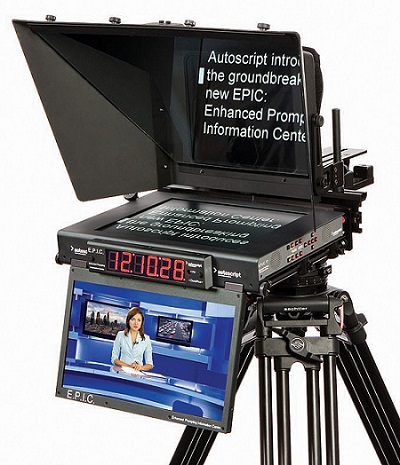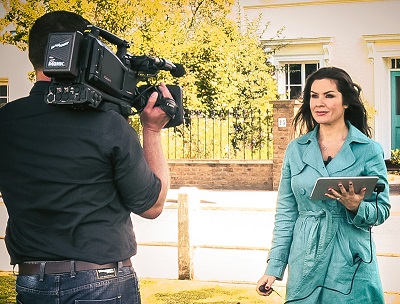Prompter Technology: A Conversation with Autoscript's Robin Brown
SPRINGFIELD, VA.—There are many critical items in the modern TV news studio, one of which is the prompter. Without a prompter, the talent would not be able to make the same one-to-one contact with the viewer. When the prompter fails in some way, the viewer is the first to see the confusion and hesitation of news anchors that seemed wise and authoritative just a moment before.
Autoscript's Epic prompting system BE Extra asked Robin Brown, product manager at Autoscript, about prompter technology, sizing and operation in order to better understand the role of this important production tool. Beyond the studio, recent prompter options are increasingly pushing the prompter into the field. However, as Brown explains, studio and field prompters can be two different animals.

BE: What size prompter is the sweet spot for studio work? What are the specs for some of the other basic necessities, such as brightness, contrast and resolution?
Brown: Prompter screen size is difficult to pin down precisely, as this is dependent on a number of factors. For example, [some of the important considerations are] studio size, distance of talent from camera, lighting conditions, productions shot requirements, script font size and even language—and of course the talent's eyesight! But generally 15- to 19-inch screens are the preferred size. Brightness and the contrast ratio of the prompter screen will help with sharpening the image but there is no Holy Grail spec.
BE: The mirror has always been a critical part of a prompter. Has there been any change in mirror technology in the past few years?
Robin Brown, product manager at Autoscript Brown: The one thing that has remained relatively unchanged is the glass/mirror. Hood designs have changed as wider lenses are more commonplace in studio production, especially on jib/crane shots right down to 4.3mm lenses. So the hood design has had to change accordingly but the vacuum coating method of creating the high quality reflective glass is unchanged.

BE: Tablets have become popular to use as prompter displays. Is this a smart choice? Is any one tablet better than another? If so, why?
Get the TV Tech Newsletter
The professional video industry's #1 source for news, trends and product and tech information. Sign up below.
Brown: Tablets have become common place in location work but not so much for studio prompting. Autoscript has an application that runs on an iPad (WinPlus Rem) that allows talent in a field location to receive the latest live updated prompter text from a studio/newsroom anywhere in the world. There are a number of mounting systems available; Autocue/QTV has a couple of versions for both above- and through-the-lens applications. However, tablets have limited use mostly due to the live editing capabilities, brightness, contrast and size. The Apple products are the preferred platform due to the available number of apps and their global commonality.
BE: What are a few important elements of the perfect studio prompting system? How close are we to that perfection?
Brown: Reliability is key. The prompter is the first contact between talent and the camera. If the prompter fails, everyone notices from the talent to the viewer. Prompter hardware, and software systems in particular, are now much more stable, function-rich and faster to react than ever. As everything is driven by the script/rundown, perfection in my eyes would be to have the prompter run the entire show by triggering events and other devices including playout, camera moves, lighting changes, robotics, etc.
Autoscript’s WinPlus Remote iPad prompting system BE: If you're considering new prompters for a studio, what considerations are there for camera pedestals and/or tripods?

Brown: Support payload capacity is the most important. Before you choose camera support, make sure you have chosen the prompter. This is often an overlooked element of the camera build-up, but in many cases determines the final choice of tripod head. A lightweight support system for a small, light camera and lens may seem appropriate until you realize your talent requires a 17-inch prompter screen. Some prompting systems will restrict the fluid head's tilt range, but this can be avoided for example with Autoscript's E.P.I.C. integrated prompting and on-air system.
BE: Is there anything else we should know about the technology and operation of prompters?
Brown: The prompter operator is more often than not the unsung hero of any news/studio production. They remain invisible but have the hot seat in any show. They have to be totally in tune with the producer/director and the talent. They need to second guess where the talent is going with an interview or item. It is not just someone scrolling the text in the back of the galley, control room or behind the curtain. So look after your operators! They can make the difference between a great show and a poor show.
Bob Kovacs is the former Technology Editor for TV Tech and editor of Government Video. He is a long-time video engineer and writer, who now works as a video producer for a government agency. In 2020, Kovacs won several awards as the editor and co-producer of the short film "Rendezvous."

